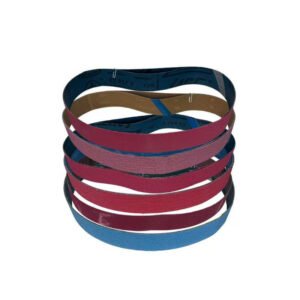Introduction
Sharpening knives with a belt sander is a popular choice among professionals and hobbyists because it offers speed, precision, and a polished finish. However, the grit size of sanding belts plays a crucial role in determining the sharpness, durability, and surface quality of the knife edge. Choosing the right grit—and the right belt size—can make all the difference between a razor-sharp blade and a dull, uneven edge.
Understanding Belt Grit for Knife Sharpening
Sanding belts are categorized by grit numbers, which indicate abrasive particle size:
- Coarse Grit (40–180 grit): Removes material quickly, best for repairing chips or reshaping dull knives.
- Medium Grit (240–400 grit): Ideal for refining edges after initial shaping, balancing sharpness with durability.
- Fine Grit (600–1200 grit): Perfect for creating a razor-sharp edge suitable for kitchen knives, hunting blades, or precision tools.
- Ultra-Fine Grit (2000–3000 grit): Used for polishing and achieving a mirror-like finish with excellent cutting performance.
👉 Recommended progression: Start with 120 grit for heavy damage, move to 400 grit for refinement, and finish with 1000–3000 grit for polishing.
Common Belt Sizes for Knife Sharpening
Belt sander size is equally important, as it affects usability, control, and compatibility with different knives. Below are the most common belt sizes for knife sharpening:
| Belt Size (mm / inch) | Best Application | Advantages | Considerations |
|---|---|---|---|
| 50 x 1500 mm (2″ x 60″) | Widely used in professional knife making | Good balance of power & control | Requires bench setup |
| 25 x 762 mm (1″ x 30″) | Compact sharpeners, hobby use | Affordable, space-saving | Limited for large blades |
| 100 x 915 mm (4″ x 36″) | General workshop use | Versatile, supports metal & wood | Heavier machine footprint |
| 150 x 1220 mm (6″ x 48″) | Industrial-scale grinding | High efficiency & speed | Requires larger workspace |
This variety allows buyers to choose a sander that matches their sharpening needs—whether for small kitchen knives or large hunting blades.
Practical Tips for Buyers
When choosing sanding belts for sharpening knives, consider these factors:
- Material of belt: Ceramic and zirconia belts last longer for aggressive sharpening, while aluminum oxide sanding belts are cost-effective for general use.
- Cooling effect: Wet/dry belts are recommended for high grits to reduce heat and prevent blade temper loss.
- Replacement strategy: Always keep multiple grit ranges (120, 400, 1000, 3000) ready for a proper sharpening workflow.
- Budget vs. durability: Investing in ceramic or structured abrasives reduces replacement frequency, ideal for workshops and factories.

(This article is based on AI generation and is for reference only. For specific usage effects, please communicate with us to purchase samples and then compare with the actual test results.)